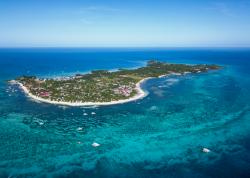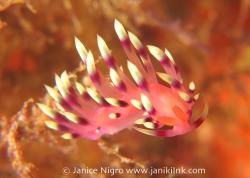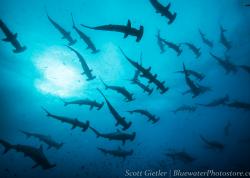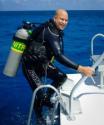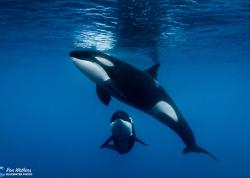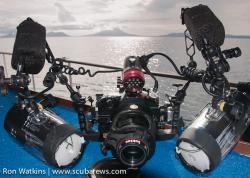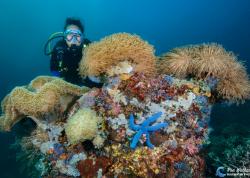Wide-Angle in the Sea of Cortez & Midriff Islands
As a University of Arizona alumnus, I was very familiar with the Sonora, Mexico seaside town of Puerto Peñasco (aka Rocky Point) and the Sea of Cortez. Only a short drive from Tucson, spring breaks were spent camping on the beach, drinking cheap beer, partying at JJ’s Cantina and eating great seafood. Later when I got PADI certified, I ventured further down the Sea of Cortez to San Carlos for my open water dives. But after traveling all over the world in search of pristine diving and big animal action, it would be over 20 years from my initial visits to the Sea of Cortez before I would learn why Jacque Cousteau described these waters as the "world's aquarium" and the "Galapagos of North America.”
The Sea of Cortez, also known as the 'Gulf of California,’ is the body of water that separates the Baja California Peninsula from the Mexican mainland. As one of the most diverse seas on the planet, the Sea of Cortez is home to a diverse and rich ecosystem, which hosts more than 5,000 different species. Some of the highlights include large colonies of sea lions, whale sharks, mysterious Humboldt squid, curious turtles, playful dolphins, giant hawkfish, jumping mobula rays, several migratory species of whales and a resident population of majestic sperm and fin whales. The Rocio del Mar liveaboard sails the Sea of Cortez and the Midriff Islands from July through September for the best diving conditions and to maximize big animal interactions. Because of the abundance of large marine life, relatively good visibility and usually mild current, the Sea of Cortez is an excellent place to learn or improve your wide-angle technique. Although the draw of many divers and underwater photographers is the large animal action, most sites also present unique and interesting macro opportunities.

Join the Underwater Photography Guide in La Paz, Sea of Cortez in October 2016.
Email us for details!

Resident sperm whales are always a thrill to see in the Sea of Cortez. On our last trip we counted about 30 sperm whales from the ship and we were able to slip into the water with a number of them.

Large pods of dolphins were a regular site as we cruised through the Sea of Cortez.
Sea Lions
Ambassadors of the Sea of Cortez
The first thing that comes to mind when I think of diving in the Sea of Cortez is the large colonies of friendly sea lions. The area around the Midriff Islands is special because there are several rookeries, like the one at San Pedro Martir, that have large California sea lion colonies with numerous protective bulls, lots of playful females and curious pups. The bulls can be easily identified by their large size, thick neck, and a bump (sagittal crest) on their forehead. They are constantly patrolling their territory to keep other bulls away from their harem and will get quite aggressive with each other and divers. Be very careful and give them space when the bulls make fast passes directly at you and bark loudly. One tip to get interesting sea lions pictures is to spend time in the shallows with them for lots of ambient light, reflections, split over/under shots and close-ups.

A sea lion pup plays in the shallows. F/8, 1/320 sec, ambient light.
All underwater wide-angle images were photographed with a Nikon D800 with a Nikon 16-35mm lens in a Sea&Sea housing with dual Sea&Sea YS250 strobes (if used)

This female lion uses the side of the rock to scratch its chest. F/9, 1/200.

A curious sea lions dives down to greet me. F/8, 1/250 sec.

A large bull patrols his territory to protect it from intruding bulls and overzealous underwater photographers. Note the white teeth marks on the fin most likely from an encounter with another bull. F/13, 1/200.
Whale Sharks (Rhincodon typus)
Largest Fish in the Sea
The Rocio del Mar typically does their whale shark snorkel (no scuba diving allowed) one day in Bahia de Los Angeles during early morning hours, when the water surface is glassy and they are easier to spot. Local fishermen take two groups out to the bay in separate boats to search for whale sharks. Although no wild animal is ever guaranteed, there is a very good chance of seeing several whale sharks during the warm summer months. We have typically seen 10-15 different whale sharks with multiple in-water encounters. Although whale sharks can get to be over 30 feet long, most in the bay area are 10-25’. The smaller ones swim slower since they’re typically feeding, and allow you to keep up with them for more time and get close to them for a great shot.
Some of our Bluewater Photo group was so excited to dive with them again after the morning session, we asked the captain to visit the bay in the afternoon and were told that they have never seen whale sharks in the afternoon. When questioned further about why they don’t see them in the afternoon, the captain responded, “We have never gone out looking for them in the afternoon because the local fishermen are taking siestas.” Subsequent Bluewater Photo trips typically feature a special itinerary with 1 ½ days swimming with the whale sharks to maximize photo opportunities. For those divers that don’t want to spend that much time with the whale sharks, an alternative reef dive is offered.
Photographing whale sharks is a lot of fun and quite easy no matter what kind of camera you have because no strobes are used (or allowed). A good wide-angle lens is needed for best results and with ambient light, try to keep the sun to your back if possible, unless you want a nice silhouette. Because you will be dropped off on both sides of the whale shark, you need to be aware of where the sun is when shooting so that you can make the necessary camera adjustments. Shooting in manual mode is a common method, but can pose difficulty when you and the shark are turning and the sun position is changing quickly. Because of this, many photographers will shoot in aperture or shutter priority and let the camera make the adjustments. I prefer shooting in shutter priority after I have dialed in the blue water I am looking for without over-exposing it. Usually that is around 1/125 – 1/250 of a second on a sunny day. I will start off with an exposure compensation setting of -.7 and adjust as needed. Make sure you review your images and their histograms frequently between in water sessions with the sharks and make the appropriate adjustments to maximize your keepers.

A snorkeler swims along side a large whale shark at Bahia de Los Angeles for an amazing encounter and great photo opportunity. F/8, 1/160 sec in shutter priority.

Sunbeams illuminate the largest fish in the ocean. F/8, 1/200 sec, shutter priority.

The Bahia de Los Angeles is a feeding ground for the whale sharks evident by this close-up of a wide-open mouth. F/8, 1/250 sec on shutter priority.
Humboldt Squid (Dosidicus gigas)
One of the most intriguing and mysterious wide-angle photo subjects in the Sea of Cortez is the Humboldt Squid. Nicknamed by local fisherman as Diablo Rojo (Red Devil) because of the flash of red and white colors, these squid can have bodies (not including tenacles) of 4-5 feet long. During the day, these squid remain at depths up to 2000 feet, and are rarely seen unless feeding on the surface at night. Humboldt squid have suckers on their tentacles, which are lined with sharp teeth that are used to secure their prey. Once caught, the squid uses its tentacles and large sharp beak to rip its victim apart. Humboldt squid can pose danger to people and one diver on our boat actually had been attacked by one and had souvenir scares to prove it. Because of this, you are not allowed in the water when photographing them and need to use a pole cam or hang over the back of the boat with your camera in the water.
The Rocio del Mar has several spots identified where Humboldt squid are known to live, but it is still very difficult to find them. The bright stern lights are turned on to attract fish and hopefully hungry squid to the surface. The crew may also use deep-water jigs to lure them up to the surface. Even if none show up, there is usually fast moving needlefish, flying fish and other fish feeding on surface to photograph. But when they do show up, it is one of the most exciting marine animals I have photographed. One night on our last trip we were fortunate to have 8-10 Humboldt Squid on the surface and witness their aggressive feeding habits and even cannibalism as they turned on each other and the hunter became the hunted.

A 3-4 foot long Humboldt Squid hunts fish on the surface with speed and precision. F/11, 1/200 sec.

When the hunter becomes the hunted by fellow cannibalistic Humboldt squid, ink is released as a defense mechanism. F/11, 1/200 sec.

A full discharge of ink allows this large Humboldt squid to escape an attack from three other larger squid. F/11, 1/200 sec.
A Diversity of Marine Life in the Sea of Cortez
The “world’s aquarium,” as described by Jacque Cousteau, has an abundance and diverse variety of marine life both big and small. Whether you are looking for big or small subjects, the Sea of Cortez has it all. I typically spend two thirds of my time shooting wide-angle, but there is also an abundance of macro opportunities. In fact, on my last trip about half the people on the boat spent most of their time shooting macro. One well-known macro and nudibranch photographer shot macro on every dive except for the whale sharks and captured some amazing images of behavior, nudibranchs, blennies, and other unique subjects.

A playful resident giant hawkfish is always a great photo subject and because they are up to two feet long, are an excellent wide angle subject. F/9, 1/125 sec.

This odd couple seemed to pose for the image. F/8, 1/160 sec.

Spanish Shawls common in Southern California waters are also abundant in the Sea of Cortez. F/32, 1/250. And Subsea diopter. All underwater macro images were photographed with a Nikon D300 with a Nikon 105mm lens in a Sea&Sea housing with dual Sea&Sea YS250 strobes.

Fighting pike blennies display their large mouths in a territorial dispute. F/32, 1/250 sec.

A pike blenny displays its dorsal fin and colors. F/20, 1/200 sec.
Why the Sea of Cortez Should be on Your Short List
The diversity of marine life, great visibility and mild currents make the Sea or Cortez an excellent place to dive. But add sea lion action, whale sharks in the calm waters of the Bahia de Los Angeles, giant cannibal Humboldt squid, sperm whales, flying mobula rays and an abundance of macro life and this place is an underwater photographers paradise. Best yet, the large custom-built Rocio del Mar live-aboard with its expert crew and food is the perfect base camp for exploring the Sea or Cortez. It’s a prefect trip for those on a budget - no need for expensive international airfare as your port of departure is Puerto Penasco, just a few hour van ride south of Phoenix. If you are interested in a trip to the Sea of Cortez, contact Bluewater Travel and join one of our guided photo workshop trips or get on an open boat. But don’t wait too long as this itinerary books up fast about a year in advance.
Further Reading
RECOMMENDED ARTICLES
SUPPORT THE UNDERWATER PHOTOGRAPHY GUIDE:
The Best Service & Prices on u/w Photo Gear
 Visit Bluewater Photo & Video for all your underwater photography and video gear. Click, or call the team at (310) 633-5052 for expert advice!
Visit Bluewater Photo & Video for all your underwater photography and video gear. Click, or call the team at (310) 633-5052 for expert advice!
The Best Pricing, Service & Expert Advice to Book your Dive Trips
 Bluewater Travel is your full-service scuba travel agency. Let our expert advisers plan and book your next dive vacation. Run by divers, for divers.
Bluewater Travel is your full-service scuba travel agency. Let our expert advisers plan and book your next dive vacation. Run by divers, for divers.




